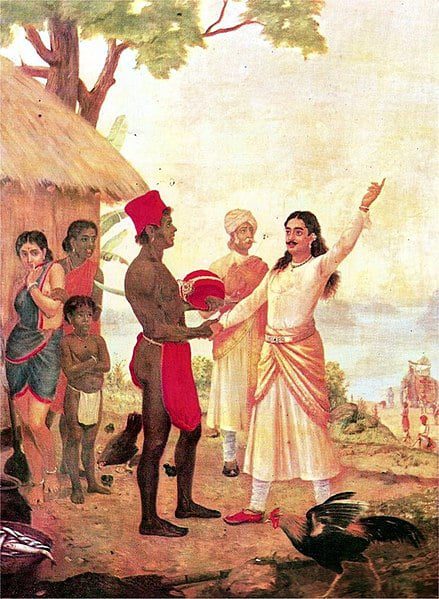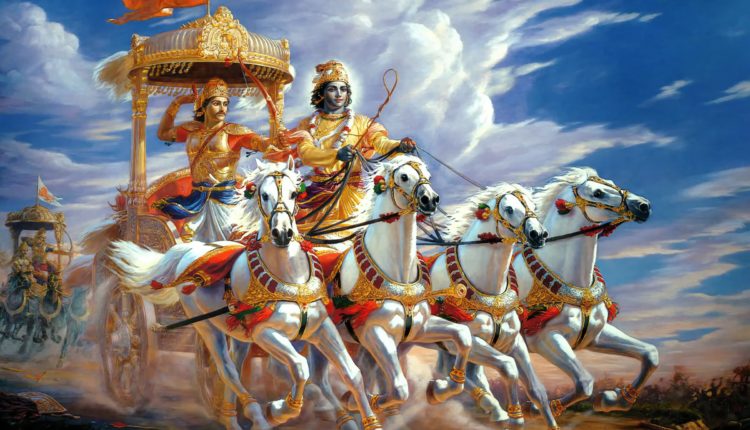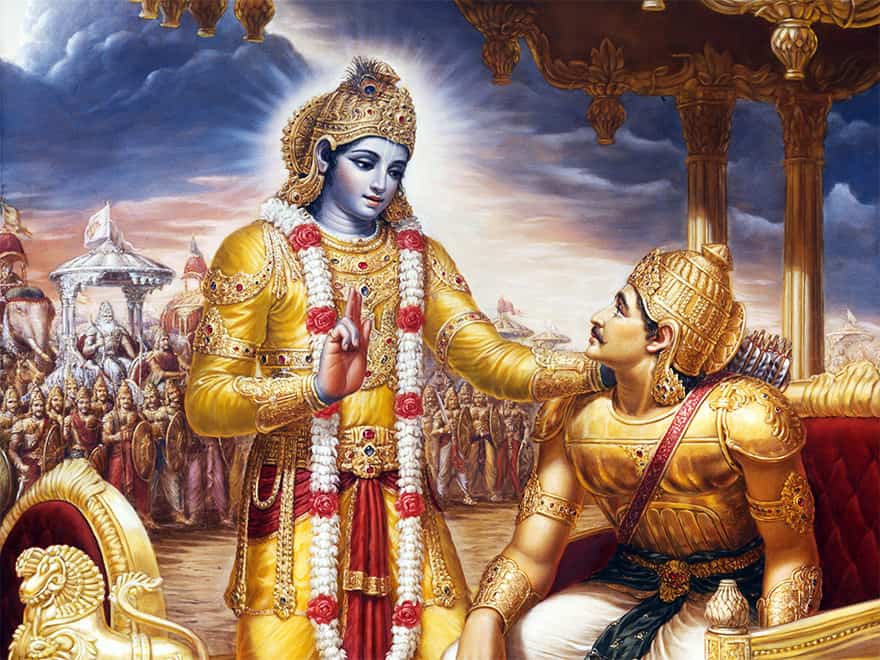What is the Mahabharata?
Mahabharata is one of the two major Sanskrit epics of ancient India, the other being the Ramayana. It is a story of dynastic struggle and conflict between two sides of a royal family, the Kuru dynasty, the Pandavas and Kauravas – which leads to a great war. The Mahabharata is believed to have been composed between 400 BCE to 400 CE and is attributed to the sage Vyasa.
Who was Bhishma?
The story of Mahabharata starts with the Kuru dynasty, where the great warrior Devavrata also known as Gangaputra (son of King Shantanu and the goddess of the river Ganga).
King of Hastinapura, Shantanu, falls in love with a woman named Satyavati, who agreed to marry him on the condition that their children would inherit the throne.

Print by Raja Ravi Varma Copyright
Gangaputra or Devavrata then takes an oath to remain celibate so he will never have any heirs and abdicates his right to the throne of the empire – so his father can give his word to Satyavati – and since his oath was selfless and of such great significance he was later known as Bheeshma.
Bheeshma was known for his valor, intelligence, and unwavering loyalty to his family. He was also an exceptional archer and skilled in the use of various weapons.
Shantanu and Satyavati had two sons – Chitrangada and Vichitravirya – but both died without any heirs.
Satyavati then convinced her son Vyasa (who was born before she was married to Shantanu) to father children with Vichitravirya’s wives, Ambika and Ambalika.
Ambika gave birth to Dhritarashtra, who was blind, and Ambalika gave birth to Pandu. Though his brother the heir to the throne was blind and thus not eligible to be the king, Pandu insists that he still be coronated as Emperor and serves the empire by expanding and assisting his older brother.
The Pandavas
He then decides to retire with his two wives to live in the forest and they have 5 sons (3 to Kunti and 2 to Madri). The five brothers were Yudhishthira, Bhima, Arjuna, Nakula, and Sahadeva respectively. They were known as the Pandavas (Sons of King Pandu)

—Yudhishthira (centre), Bhima (bottom left), Arjuna (bottom right),
Nakula and Sahadeva (both standing beside the throne)—with Draupadi.
The Kauravas
The Kuru dynasty is now divided into two families, the Pandavas and the Kauravas. The Kauravas were the hundred sons of Dhritarashtra, the blind emperor of Hastinapura, and his wife Gandhari. The Kauravas were headed by Duryodhana, the eldest and most powerful of the brothers.
The Pandavas and Kauravas were raised together in Hastinapura, but their childhood was marked by rivalry and conflict. The Kauravas, led by Duryodhana, were jealous of the Pandavas’ skills and popularity, and sought to undermine them at every opportunity.
The Mahabharata: Complete and Unabridged (Set of 10 Volumes with Box)
Mahabharata by Amar Chitra Katha- The Birth of Bhagavad Gita- 42 Comic Books in 3 Volumes
Drona
As young men, the Pandavas were sent to study under the sage Drona, who taught them the art of warfare, along with the Kauravas.
However, Drona favored the Pandavas, which only fueled Duryodhana’s resentment.
Karna
Meanwhile, the story of Karna adds a significant dimension to the rivalry between the Pandavas and Kauravas. Karna was born to Kunti before she was married to Pandu, and was abandoned as a baby.

He was raised by a charioteer, but grew up to become a skilled warrior and friend of Duryodhana. Karna’s desire to prove himself to the world and his loyalty to Duryodhana made him an antagonist to the Pandavas.
The Exile
As the story unfolds, a game of dice becomes the turning point in the rivalry between the Pandavas and Kauravas. Duryodhana invites Yudhishthira to a game of dice and cheats to win, the Pandavas lose their kingdom and are forced to go into exile for twelve years, followed by a year of living incognito.
During their exile, the Pandavas have various adventures and learn new skills. Arjuna, in particular, receives training in archery from the god Indra and acquires various celestial weapons, including the powerful Brahmastra.
At the end of their exile, the Pandavas demand their rightful share of the kingdom, but Duryodhana refuses to give it up. This leads to a war between the two sides, which becomes the central event of the Mahabharata.
The war at Kurukshetra
The war is fought between the Pandavas and their allies, including Krishna, and the Kauravas and their allies, including Karna in a place called Kurukshetra, a town which exists in Northern India to this day.
The war lasts for eighteen days and is one of the bloodiest conflicts in human history. The war is described in great detail in the Mahabharata, with various battles and heroic feats on both sides.
The central dilemma faced by Arjuna before the start of the war is also a significant part of the story.
The Mahabharata: Complete and Unabridged (Set of 10 Volumes with Box)
Mahabharata by Amar Chitra Katha- The Birth of Bhagavad Gita- 42 Comic Books in 3 Volumes
Arjuna’s Dilemma – and the solution – Bhagawad Gita
Arjuna is overcome with doubt and despair at the thought of fighting his own relatives and friends, but Krishna counsels him on the nature of duty and detachment, leading to the teachings of the Bhagavad Gita.
The war involves the use of various celestial weapons, including the Brahmastra and Narayanastra, and leads to the deaths of many prominent warriors, including Bhishma, Drona, Karna, son’s of the Pandavas and the Kauravas themselves.

The war ends with the Pandavas emerging victorious, and Yudhishthira becomes the king of Hastinapura. However, the victory comes at a great cost, and the Pandavas are left with a profound sense of loss and grief.
Many years after the war, a great flood devastates the land, and the Pandavas, along with many of their allies, decide to renounce the world and embark on a journey to the heavens.
However, one by one, the Pandavas and Draupadi fall on their journey. Only Yudhishthira is able to reach heaven, accompanied by his faithful dog. There, he finds his brothers and Draupadi, who have all been sent to various parts of heaven according to their merits and demerits.
The Mahabharata is an epic tale of family, rivalry, love, loyalty, and duty. It has been passed down through the ages as an oral tradition, with various versions and interpretations.
The first known written version of the Mahabharata is attributed to the sage Vyasa, who is said to have composed it in Sanskrit around 400 BCE.
What is the Bhagawad Gita?
The Bhagavad Gita (literally translates to God’s words), which is a central part of the Mahabharata, is a philosophical dialogue between Arjuna and Krishna on the nature of duty and detachment.
It is often interpreted as a guide to ethical and moral behavior, and has been widely studied and revered by Hindus and non-Hindus alike.
The Bhagavad Gita is a section of the Mahabharata and is considered one of the most important philosophical texts in Hinduism.

In the Bhagavad Gita, the god Krishna imparts spiritual teachings to the warrior Arjuna on the battlefield of Kurukshetra, just before the start of the great war. The Bhagavad Gita presents various philosophical and spiritual concepts, including the nature of the self, the meaning of action and detachment, and the path to ultimate liberation. It emphasizes the importance of devotion, doing one’s duty (dharma), knowledge, and surrender to the divine.
Top Image Source
What movies were made on the Mahabharata?
Like the Ramayana, Mahabharata is a beloved epic. Both are stories which will take days just to read the high level stories.
On TV series were made twice – and ran for a long time. Both were very popular in and outside India.
The first series aired – 1988-1990 and the next on aired 2013-2014
However, like Ramayana – the telugu film industry from southern India also produced a lot of movies dealing with specific parts of the story and those are at least 2.5 – 3 hrs long for really small portions of the story. Below are some of those.
What other countries venerate the Mahabharata?
The Mahabharata is an ancient Indian epic poem that is widely regarded as one of the greatest works of literature in the world.
Its influence on Indian culture, history, arts, and philosophies is immense, but it has also had a significant impact on neighboring countries. Here are some details by country:
Nepal: Nepal has close cultural ties with India, and the Mahabharata is an integral part of Nepalese culture. Many Nepalese temples and shrines have depictions of scenes from the Mahabharata, and the epic has had a significant impact on Nepalese literature, music, and art.
Bhutan: Bhutan has a strong Buddhist tradition, but the Mahabharata has still had an impact on Bhutanese culture. The epic has been translated into the Bhutanese language, and its themes and stories have been incorporated into Bhutanese folklore and legends.
Myanmar (Burma): The Mahabharata has had a significant impact on Burmese culture, especially in the area of literature. Burmese translations of the Mahabharata have been popular for centuries, and many Burmese writers have drawn inspiration from the epic.
Sri Lanka: The Mahabharata has had a significant impact on Sri Lankan culture, particularly on the island’s Hindu and Buddhist communities. The epic has been translated into Sinhalese and Tamil, and its themes and stories have been incorporated into Sri Lankan literature and art.
Thailand: The Mahabharata has had a limited impact on Thai culture, but there are some significant connections. Thai classical dance and drama often draw on stories and themes from the Mahabharata, and there are some depictions of scenes from the epic in Thai art.
Indonesia: The Mahabharata has had a significant impact on Indonesian culture, especially on the island of Java. The epic has been translated into Indonesian, and its themes and stories have been incorporated into Javanese folklore and literature. The wayang kulit, a form of shadow puppetry, often features stories from the Mahabharata.
Cambodia: The Mahabharata has had a significant impact on Cambodian culture, particularly in the area of dance and drama. Cambodian classical dance often draws on stories and themes from the Mahabharata, and there are some depictions of scenes from the epic in Cambodian art.
Laos: The Mahabharata has had a limited impact on Lao culture, but there are some connections. The epic has been translated into Lao, and some Lao literature and art draw on stories and themes from the Mahabharata.
Vietnam: The Mahabharata has had a limited impact on Vietnamese culture, but there are some significant connections. Vietnamese translations of the Mahabharata have been popular for centuries, and some Vietnamese literature and art draw on stories and themes from the epic.
Overall, the Mahabharata has had a wide-reaching impact on the cultures of many countries beyond India, particularly in Southeast Asia. Its stories and themes continue to inspire and resonate with people across borders and cultures, making it a truly universal epic.
Disclaimer:
This is NOT an exhaustive excerpt. It takes days or weeks to go through the entire volume of work for this epic.
Each character has origin stories in great detail and those details help the reader or listener to understand the complexity of that character and their ultimate role in the entire story.
The above is a heavily summarized version and by no means should it be considered as an accurate representation. It is simply an attempt to introduce the epic to someone who has no idea of what this is all about.
